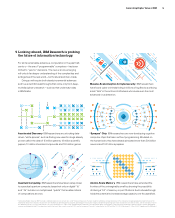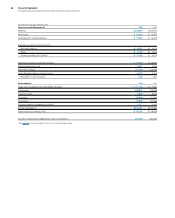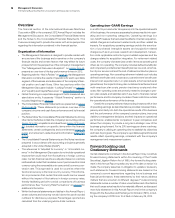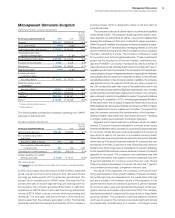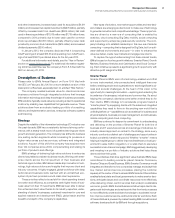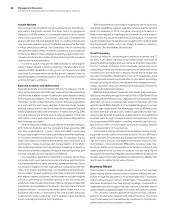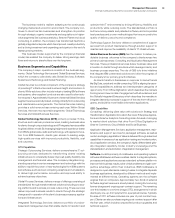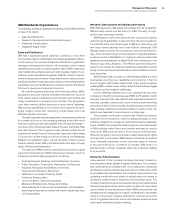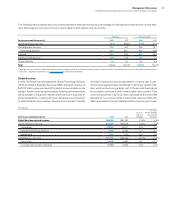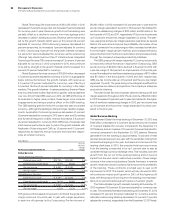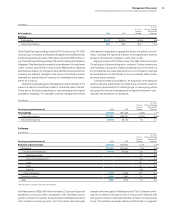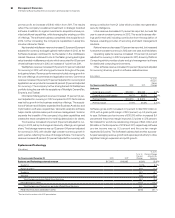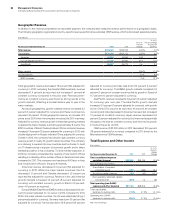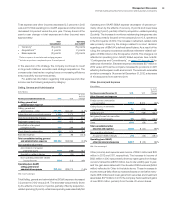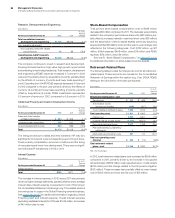IBM 2012 Annual Report Download - page 25
Download and view the complete annual report
Please find page 25 of the 2012 IBM annual report below. You can navigate through the pages in the report by either clicking on the pages listed below, or by using the keyword search tool below to find specific information within the annual report.2424 Management Discussion
International Business Machines Corporation and Subsidiary Companies
Software Capabilities
WebSphere Software: delivers capabilities that enable organizations
to run high-performance business applications. With these applica-
tions, clients can integrate and manage business processes across
their organizations with the flexibility and agility they need to respond
to changing conditions. Built on services-oriented architecture
(SOA), and open standards support for cloud, mobile and social
interactions, the WebSphere platform enables enterprises to extend
their reach and optimize interactions with their key constituents.
Smarter Commerce software helps companies better manage and
improve each step of their value chain and capitalize on opportunities
for profitable growth, efficiency and increased customer loyalty.
Information Management Software: enables clients to integrate,
manage and analyze enormous amounts of data from a large variety
of sources in order to gain competitive advantage and improve their
business outcomes. With this approach, clients can extract real value
out of their data and use it to make better business decisions. IBM’s
middleware and integrated solutions include advanced database
management, information integration, data governance, enterprise
content management, data warehousing, business analytics and intel-
ligence, predictive analytics and big data analytics.
Tivoli Software: helps clients optimize the value they get from
their infrastructures and technology assets through greater visibility,
control and automation across their end-to-end business opera-
tions. These asset management solutions foster integrated service
delivery for cloud and datacenter management, enterprise endpoint
and mobile device management, asset and facilities management,
and storage management. Tivoli includes security systems software
that provides clients with a single security intelligence platform that
enables them to better secure all aspects of their enterprise and
prevent security breaches.
Lotus Software: enables businesses to connect people and pro-
cesses for more effective communication and increased productivity
through collaboration, messaging and social networking software. By
remaining at the forefront of collaboration tools, IBM’s social business
offerings help organizations reap real benefits associated with social
networking, as well as create a more efficient and effective workforce.
Rational Software: supports software development for both IT, as
well as complex and embedded system solutions, with a suite of
Collaborative Lifecycle Management products. Jazz, Rational’s tech-
nology platform, transforms the way people work together to build
software, making software delivery more integrated and collabora-
tive, while optimizing for successful business outcomes.
Operating Systems: software that manages the fundamental
processes that make computers run.
Systems and Technology (STG) provides clients with business
solutions requiring advanced computing power and storage capa-
bilities. Approximately half of Systems and Technology’s server and
storage sales transactions are through the company’s business
partners; with the balance direct to end-user clients. In addition,
Systems and Technology provides leading semiconductor technology,
products and pack aging solutions for IBM’s own advanced technol-
ogy needs and for external clients.
Systems and Technology Capabilities
Systems: a range of general purpose and integrated systems
designed and optimized for specific business, public and scientific
computing needs. These systems—System z, Power Systems and
System x—are typically the core technology in data centers that
provide required infrastructure for business and institutions. Also,
these systems form the foundation for IBM’s integrated offerings,
such as IBM PureSystems, IBM Smart Analytics, IBM Netezza,
IBM SmartCloud Entry and IBM BladeCenter for Cloud. IBM serv-
ers use both IBM and non-IBM microprocessor technology and
operating systems. All IBM servers run Linux, a key open-source
operating system.
Storage: data storage products and solutions that allow clients to
retain and manage rapidly growing, complex volumes of digital infor-
mation. These solutions address critical client requirements for
information retention and archiving, security, compliance and stor-
age optimization including data deduplication, availability and
virtualization. The portfolio consists of a broad range of disk and
tape storage systems and software.
Microelectronics: semiconductor design and manufacturing primarily
for use in IBM systems and storage products as well as delivering
semiconductors and related services to external clients.
Global Financing facilitates clients’ acquisition of IBM systems,
software and services. Global Financing invests in financing assets,
leverages with debt and manages the associated risks with the
objective of generating consistently strong returns on equity. The
primary focus on the company’s offerings and clients mitigates
many of the risks normally associated with a financing company.
Global Financing has the benefit of both a deep knowledge of its
client base and a clear insight into the products and services that
are being financed. This combination allows Global Financing to
effectively manage two of the major risks (credit and residual value)
that are normally associated with financing.
Global Financing Capabilities
Client Financing: lease and loan financing to end users and internal
clients for terms generally between one and seven years. Internal
financing is predominantly in support of Global Services’ long-term
client service contracts. Global Financing also factors a selected
portion of the company’s accounts receivable, primarily for cash
management purposes. All internal financing arrangements are at
arm’s-length rates and are based upon market conditions.
Commercial Financing: short-term inventory and accounts receiv-
able financing to dealers and remarketers of IT products.
Remanufacturing and Remarketing: as equipment is returned at
the conclusion of a lease transaction, these assets are refurbished
and sold or leased to new or existing clients both externally and
internally. Exter nally remarketed equipment revenue represents
sales or leases to clients and resellers. Internally remarketed equip-
ment revenue primarily represents used equipment that is sold
internally to Systems and Technology and Global Services. Systems
and Technology may also sell the equipment that it purchases from
Global Financing to external clients.



